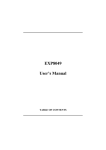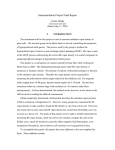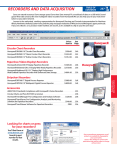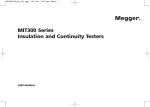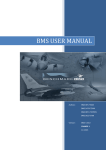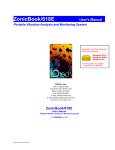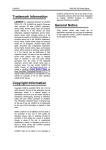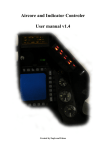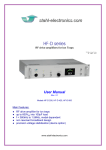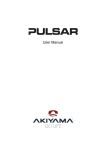Download 652u and 655u User`s Manual
Transcript
USER’S MANUAL 652u and 655u Dynamic Signal Analyzers for Vibration Analysis and Monitoring IOtech 25971 Cannon Road Cleveland, OH 44146-1833 *372562B-01* 372562B-01 1177-0901 rev 2.0 (440) 439-4091 Fax: (440) 439-4093 [email protected] [email protected] www.iotech.com Warranty Information Your IOtech warranty is as stated on the product warranty card. You may contact IOtech by phone, fax machine, or e-mail in regard to warranty-related issues. Phone: (440) 439-4091, fax: (440) 439-4093, e-mail: [email protected] Limitation of Liability IOtech cannot be held liable for any damages resulting from the use or misuse of this product. Copyright, Trademark, and Licensing Notice All IOtech documentation, software, and hardware are copyright with all rights reserved. No part of this product may be copied, reproduced or transmitted by any mechanical, photographic, electronic, or other method without IOtech’s prior written consent. IOtech product names are trademarked; other product names, as applicable, are trademarks of their respective holders. All supplied IOtech software (including miscellaneous support files, drivers, and sample programs) may only be used on one installation. You may make archival backup copies. CE Notice Many IOtech products carry the CE marker indicating they comply with the safety and emissions standards of the European Community. When applicable these products have a Declaration of Conformity stating which specifications and operating conditions apply. You can view our Declarations of Conformity at www.iotech.com/CE Warnings, Cautions, Notes, and Tips Refer all service to qualified personnel. This caution symbol warns of possible personal injury or equipment damage under noted conditions. Follow all safety standards of professional practice and the recommendations in this manual. Using this equipment in ways other than described in this manual can present serious safety hazards or cause equipment damage. This warning symbol is used in this manual or on the equipment to warn of possible injury or death from electrical shock under noted conditions. This ESD caution symbol urges proper handling of equipment or components sensitive to damage from electrostatic discharge. Proper handling guidelines include the use of grounded anti-static mats and wrist straps, ESD-protective bags and cartons, and related procedures. This symbol indicates the message is important, but is not of a Warning or Caution category. These notes can be of great benefit to the user, and should be read. In this manual, the book symbol always precedes the words “Reference Note.” This type of note identifies the location of additional information that may prove helpful. References may be made to other chapters or other documentation. Tips provide advice that may save time during a procedure, or help to clarify an issue. Tips may include additional reference. Specifications and Calibration Specifications are subject to change without notice. Significant changes will be addressed in an addendum or revision to the manual. As applicable, IOtech calibrates its hardware to published specifications. Periodic hardware calibration is not covered under the warranty and must be performed by qualified personnel as specified in this manual. Improper calibration procedures may void the warranty. CAUTION Using this equipment in ways other than described in this manual can cause personal injury or equipment damage. Before setting up and using your equipment, you should read all documentation that covers your system. Pay special attention to Warnings and Cautions. Note: During software installation, Adobe® PDF versions of user manuals will automatically install onto your hard drive as a part of product support. The default location is in the Programs group, which can be accessed from the Windows Desktop. Initial navigation is as follows: Start [on Desktop] Programs IOtech … You can also access the PDF documents directly from the data acquisition CD by using the <View PDFs> button located on the opening screen. Refer to the PDF documentation for details regarding both hardware and software. IOtech 652u and 655u User’s Manual Table of Contents F Quick Start, 652u and 655u Chapter 1 – What are the 652u and 655u? Chapter 2 – Block Diagram Chapter 3 – Connectors, Indicators, and Cables Front Panel (Analog) Connectors …… 3-1 Introduction …. 3-1 Analog Common …… 3-1 Current Source (IEPE) with Transducer Fault Detection ……. 3-1 Input Coupling …… 3-2 Anti-Aliasing …… 3-2 Analog Triggers …… 3-2 Rear Pannel Connectors and Indicators …… 3-2 External Power ……3-3 Digital I/O (requires eZ-TOMAS)…… 3-3 #6-32 Machine Screw (chassis to earth ground)…… 3-4 USB2.0 …… 3-4 LED Indicators …… 3-4 5 Channel TC / RTD Connector (655u only) …… 3-4 Chapter 4 – CE Compliance and Noise Considerations Overview …… 4-1 CE Standards and Directives …… 4-1 Safety Conditions ……4-2 Emissions/Immunity Conditions …… 4-3 CE Rules of Thumb for 652u and 655u …… 4-3 Noise Considerations …… 4-4 Chapter 5 – Software Options for 600 Series Devices eZ-Analyst …… 5-2 eZ-TOMAS …… 5-3 eZ-Balance …… 5-4 eZ-NDT …… 5-5* Chapter 6 – Product Care and Customer Support Electrostatic Discharge (ESD), Handling Notice…… 6-1 Product Care …… 6-1 ReadMe Files and the Install CD-ROM …… 6-2 Customer Support …… 6-2 Chapter 7.a – Specifications, IOtech 652u and 655u 7.b – Specifications, Data Plots Appendix A – Changing the Device Name *eZ-NDT does not support IOtech 652u or 655u. IOtech 652u and 655u User’s Manual 917891 IOtech 652u and 655u Quick Start 10-Channel, USB2.0 Dynamic Signal Analyzers for Vibration Analysis & Monitoring Before you get started verify that you have a 32-bit version of Windows, the following items, and meet or exceed the minimum requirements listed. • • • • • IOtech 652u or 655u TR-2U Power Supply USB2.0 port [on PC] and USB Cable Dynamic Signal Analysis CD License Keys for purchased software; e.g., eZ-Analyst, eZ-TOMAS • Monitor: SVGA, 1024 x 768 screen resolution • Windows 2000 SP4 and Windows XP users: Intel™ Pentium 4 or equivalent 1 GB memory; 10 GB disk space • Windows Vista (x86) users: PC must be Windows Vista Premium Ready Step 1 - Install Software 1. Close all running applications on the host PC. 2. Insert the Dynamic Signal Analysis CD into your CD-ROM drive and wait for the CD to auto-run. An Opening Screen will appear. As an alternative, you can download software from: www.iotech.com/ftp.html 3. Click the <ENTER SETUP> button. Note: If you are downloading software from our website, follow instructions provided there. 4. From the hardware selection screen [which follows a licensing agreement], select the 652u or 655u from the drop-down list and follow the on-screen instructions. Step 2 - Connect the 652u [or 655u] to Power and to the Computer Supply power from the TR-2U to the 652u [or 655u] before connecting the USB cable to the computer. This allows the unit to inform the host computer (upon connection of the USB cable) that the hardware requires minimal power from the computer’s USB port. When disconnecting a 652u [or 655u] from the PC, unplug the USB cable before unplugging the TR-2U power cable. 652u or 655u [rear panel] Note: The 655u rear panel includes a connector block for 5 temperature channels, not shown. 1. Connect the TR-2U to a standard AC outlet. 2. Connect the TR-2U to the External Power connector on the 652u [or 655u]. 3. Using a USB cable, connect the 652u [or 655u] to a USB2.0 port on the computer. 4. Follow the computer screen prompts as directed to allow the computer to detect your new hardware. 1170-0940 rev 2.0 324996B-01 LED Notes: The “Power” LED blinks during device detection and initialization; then remains on solid as long as the module has power. If there is insufficient power the LED will go off. The “Active” LED is on whenever active communication is taking place between 652u [or 655u] and the host PC. It will be on solid during data acquisitions. Step 3 - Connect Data Acquisition Signal Lines CAUTION Turn off power to the system devices and externally connected equipment before connecting cables. Electric shock or damage to equipment can result even under low-voltage conditions. Take ESD precautions (packaging, proper handling, grounded wrist strap, etc.) The 652u and 655u each have 10 analog channel inputs (CH1 through CH10) via front panel BNC connectors and 8 digital I/O lines via rear panel DB9 connector. In addition, the 655u has a removable block that provides a means of connecting thermocouples and/or RTDs (5 total temperature channels, regardless of TC, RTD, or mix). Digital I/O Channel Designation (outer numbers) Prior to making signal connections review the Specifications chapter of your 652u and 655u user’s manual to ensure that the input signals do not exceed the specified limits. The manual is included in PDF format on the CD and covers both the 652u and the 655u. The following figures pertain to temperature channels and apply to the 655u only. The 652u cannot accept temperature connections, nor can it measure temperature. To ensure accurate temperature measurements allow the 655u to acclimate itself to ambient temperature prior to acquiring data. TC/RTD Connector Pinout (655u only) Wiring Schematics (655u only) Reference Notes: Adobe Acrobat PDF versions of documents pertaining to IOtech 652u and 655u are automatically installed onto your PC’s hard-drive as a part of product support at the time of software installation. The default location is the Programs group. It can be accessed via the Windows Desktop Start Menu. IOtech 25971 Cannon Road, Cleveland, OH 44146-1833 Phone: (440) 439-4091, Fax: (440) 439-4093 E-mail: [email protected] E-mail: [email protected] Internet: www.iotech.com *324996B-01* 324996B-01 Printed in Hungary What are the IOtech 652u and 655u? 1 IOtech 652u Front and Rear Panels IOtech 655u Front and Rear Panels IOtech 652u and 655u are dynamic signal analyzers used for monitoring and analyzing machinery and structures in regard to sound, vibration, and rotation. In addition, the 655u includes a block on the right-side of the rear panel for connecting up to five temperature channels via thermocouples and/or RTDs. For both the 652u and 655u, the device hardware is the signal conditioning and acquisition engine, while the software defines the specific analysis and monitoring features of the system. Since the software [in the host PC] determines which capabilities will be used, it is easy to upgrade the system and add more capabilities over time. Basic profile: Model Interface Temperature Channels Analog Input Channels High Pass Filter Cutoff Analog Input Range Analog Output Channels Digital I/O Channels External Power Connector 652u USB2.0 0 10 0.1 Hz ±40 V 0 8 6 to 16 VDC 1 amp (max.) 655u USB2.0 5 10 0.1 Hz ±40 V 0 8 6 to 16 VDC 1 amp (max.) The IOtech 652u and 655u each include a high-speed USB2.0 engine. The USB interface allows all acquired data to be transferred to the PC in real time at 1.05 Meg samples/sec. This means that every acquired data point can reside on the host PC’s hard drive, making re-creation and post acquisition analysis of acquired data as precise as possible. The 652u, 655u (and also our 640e, 640u, 650e, and 650u) transmit all time-domain measurements. This means there is no data loss when analyzing acquired waveforms. Since the data is already on the host PC’s hard drive there is no time lost transferring data. The 652u / 655u architecture is such that there is virtually no limit to the length of time continuous data can be acquired. The only limitation is the amount of available hard disk memory on the host PC, or that which can be accessed by a PC on a network. IOtech 652u and 655u User’s Manual 917291 What are the IOtech 652u and 655u? 1-1 Features of the Dynamic Signal Inputs o a current source for transducer biasing (IEPE) o detection of a transducer fault o AC coupling: 0.1 Hz; or DC coupling o ±40 V range o anti-aliasing filters: 3-pole low pass filter in hardware; software FIR filters are automatically set for each analysis rate o pseudo-differential inputs o support for TEDS (Transducer Electronic Data Sheet) in eZ-Analyst o any analog input channel can serve as a tach input o tight channel-to-channel phase matching USB2.0 ready: Easy Connection to USB2.0-ready Notebooks, Desktop PCs, or USB2.0 Hubs. Note that the USB2.0 port allows a continuous stream of data to be collected and stored in the host PC. Analog Input Channels: 10 BNC connectors Temperature Measurement Channels (655u only): 5 channels, thermocouple or RTD. Wiring connects to 655u rear panel via a removable connector block. 8 Digital I/O Channels: DB9 connector for connection of Digital I/O signal lines. Note: eZ-NDT or eZ-TOMAS software must be used to make use of the Digital I/O. Analog Channel Triggering Pre- and Post-Trigger Readings Reference Notes: For information regarding 655u connections for temperature measurement, refer to chapter 3. For information regarding software, refer to chapter 5. 1-2 What are the IOtech 652u and 655u? 917891 IOtech 652u and 655u User’s Manual Block Diagram 2 IOtech 652u and 655u Block Diagram ** See page 2-2 for temperature channel block diagram. IOtech 652u and 655u User’s Manual 878091 Block Diagram 2-1 This temperature channel block diagram applies only to the 655u. The 5 channel TC / RTD removable connector connects to the rear panel of the 655u. Temperature Channel Block Diagram (655u only) *The gray block for temperature channel 1 (TEMP. CH 1) is also representative of the remaining four temperature channels. 2-2 Block Diagram 878091 IOtech 652u and 655u User’s Manual General Comments The following short descriptions are provided to supplement the block diagrams presented on pages 2-1 and 2-2. For additional information refer to Chapter 3, Connectors, Indicators, and Cables. USB2.0 The IOtech 652u and 655u transfer acquired data to the PC via a USB2.0 connection. It is important to note that USB ports and USB hubs cannot supply sufficient power to 652u or 655u. Power Power (6 to 16VDC at 400mA) is typically supplied by a TR-2U power adapter connected to the External Power Jack. An equivalent source of DC power can be used in place of a TR-2U. LEDs Active The Active LED is on whenever active communication is taking place between the 652u [or 655u] and the host PC. Note that the Active LED will be on solid during a data acquisition. Power The “Power” LED blinks during device detection and initialization; then remains on solid as long as the module has power. If there is insufficient power the LED will go off. Digital I/O To make use of the Digital I/O feature the 652u [or 655u] must be operating with eZ-TOMAS or eZ-NDT. The 8-bits of digital I/O are provided via a rear panel DB9 connector. Each bit is programmable as input or output. BNCs Up to ten BNC connectors, designated as Channels 1 through 10, can be used to connect analog input signals to the 652u [or 655u]. The BNC center-conductor is the signal HI and the BNC shell is the signal LO. 5 Channel TC / RTD (Applies to the 655u only) The 5 channel TC / RTD removable connector connects to the rear panel of the 655u. The connector can be used to connect up to five temperature measurement channels. Each channel can use a thermocouple or an RTD. Removable Connector Chapter 3 includes a connector pinout and wiring diagrams for the following: • • • • Thermocouple TD 4-wire RTD 3-wire RTD-2 wire Note: Earth grounds are available for shielded sensors. IOtech 652u and 655u User’s Manual 878091 Block Diagram 2-3 Connectors, Indicators, and Cables 3 Front Panel (Analog) Connectors …… 3-1 Introduction …. 3-1 Analog Common …… 3-1 Current Source (IEPE) with Transducer Fault Detection ……. 3-1 Input Coupling …… 3-2 Anti-Aliasing …… 3-2 Analog Triggers …… 3-2 Rear Pannel Connectors and Indicators …… 3-3 External Power ……3-3 Digital I/O (requires eZ-TOMAS)…… 3-3 #6-32 Machine Screw (chassis to earth ground)…… 3-4 USB2.0 …… 3-4 LED Indicators …… 3-4 5 Channel TC / RTD Connector (655u only) …… 3-4 Front Panel (Analog) Connectors Front Panel – Aside from the model number, the 652u and 655u front panels look the same Introduction The front panel includes ten BNC connectors for voltage input. These are labeled CH1 through CH10. The front panel also includes analog common. The IOtech 652u and 655u include circuitry for dynamic analog signal conditioning. The circuitry typically interfaces with piezoelectric transducers that include, but are not limited to: accelerometers, microphones, and force/pressure transducers; and non-piezoelectric transducers such as tachometers and proximity probes. Features of 652u and 655u dynamic signal conditioning circuits include: o o o o o o o o o o current source for transducer biasing (IEPE) detection of a transducer fault AC or DC coupling ±40 V range anti-aliasing filters: 3-pole low pass filter in hardware; programmable digital filtering via software pseudo-differential inputs support for TEDS (Transducer Electronic Data Sheet), requires eZ-Analyst any analog input channel can serve as a tach input tight channel-to-channel phase matching signal parameters are independently controlled in software on a per channel basis Analog Common The BNC shells for the analog input channels have a 1k ohm resistance from the BNC shell to analog ground. The BNC center-conductor is the signal HI and the BNC shell is the signal LO. Each BNC shell is connected to the chassis ground through its own channel-dedicated 1 kΩ resistor. Consequently, the shell is not meant to be driven more than ±8V from earth ground to BNC shell. If the host computer is a desktop PC, then the computer ground will likely connect to the AC power line ground. If the host computer is a notebook PC, then the computer ground could be: (a) floating, for example, when operating on batteries, or (b) connected to a vehicle ground, for example, when using an automotive cigarette lighter adapter in conjunction with the vehicle’s battery. TIP: Additional measurement noise may be present when using earth grounded transducers. For best results electrically isolate the input transducers from earth ground. 652u & 655u User’s Manual 989490 Connectors, Indicators, and Cables 3-1 Current Source (IEPE) with Transducer Fault Detection Note: IEPE current source can only be enabled when AC Coupling is selected. If IEPE is selected in software, a constant current is supplied to bias IEPE transducers. The bias current is sourced through the center conductor of the input channel BNC connector and returns to the conditioning circuit by the outer conductor. The current source features a voltage operating compliance and is short-circuit and over-voltage protected as stated in the specifications. Operating compliance refers to the highest voltage that can be sourced without change of the current source value. In the absence of a transducer, the current source will output a higher open circuit voltage. For unused channels and for other applications that do not require bias, the current source should be disabled from the input via software control, on a per channel basis. When the current source is enabled, the input voltage is continuously monitored with level detection circuitry for indicating an open transducer (high voltage) or a transducer short (low voltage). Existence of either condition triggers a transducer fault for the associated channel. This error is communicated to the user on the monitor via software and is also available through a software status request at the end of an acquisition. Faults are detected and communicated when present. Detection of a fault does not alter the acquisition process or its data. Input Coupling The analog input channels can be independently set in software to AC Coupling or to DC Coupling. When AC Coupling is selected, the input signal passes through a high pass filter. When DC Coupling is selected the high-pass filter is bypassed. Anti-Aliasing The 652u and 655u analyzers each include three-pole anti-aliasing filters and 24-bit sigma/delta analog-to-digital converters (ADC). The converters exhibit an alias frequency band between 1.69MHz and 6.75MHz, which eases the requirements of the anti-aliasing filters. Transducers seldom have significant energy at these high frequencies. However, should there happen to be such energy, the filters will attenuate it. Refer to the specifications chapter for details, including a response chart. Analog Triggers The IOtech 652u and 655u signal analyzers can be triggered per software configuration relevant to the 10 analog input channels. Refer to the associated software documentation regarding the various types of triggers and how to set them. Reference Notes: For detailed information, refer to the applicable software document, i.e., eZ-TOMAS or eZ-Analyst. PDF versions of the documents can be accessed via the <View PDFs> button on the Dynamic Signal Analysis (DSA) CD’s opening screen. In addition to software documentation, information regarding aliasing, anti-aliasing, sensors, accelerometers, sound and vibration, and transducers may prove useful to your application. The internet is a great source for this material. In regard to TEDS (Transducer Electronic Data Sheet), you may find the IEEE 1451 standard to be of interest. 3-2 Connectors, Indicators, and Cables 989490 652u & 655u Users Manual Rear Panel Connectors and Indicators IOtech 652u Rear Panel, Partial View IOtech 655u 5 Channel TC / RTD Connector Note: For Connector Shell Information see page 3-6. The rear panels of both the 652u and 655u include, from left to right: an External Power connector, DB9-Digital I/O port, USB2.0 connector, a #6-32 chassis ground, and two status LEDs (ACTIVE and POWER). In addition, the rear panel of the 655u includes a 24 pin removable block connector that provides a means of connecting up to 5 thermocouples, RTDs, or a combination of the two. The connection block is located just to the right of the LEDs. Pinouts and schematics are provided at the end of this chapter. EXT POWER: +6 to +16 VDC, 1 amp (maximum). Power is typically supplied from a TR-2U power adapter. The TR-2U is an AC-to-DC conversion power supply with the following ratings: o Input voltage to TR-2U: 90-264 VAC o TR-2U voltage output (supply to 652u, or 655u): typically 9VDC o Max Current Output: 1.7 amp; but will typically output 400mA to meet the 652u’s [or 655u’s] relatively small power demand. DIGITAL I/O (Note: requires eZ-TOMAS installed on the host PC) Eight digital I/O lines are accessible via a 9-pin, female DSub connector. Each bit of digital I/O can be programmed individually to be either an input or an output. By hardware default, the digital I/O port boots up as an input. This is to prevent any 652u [or 655u] digital output from possibly damaging external hardware. Digital I/O Channel Numbers Digital I/O Connector DB9 –on rear panel The digital I/O can be read synchronously or asynchronously. It can also be read asynchronously while being in a synchronous acquisition. Synchronously, the digital I/O will be read at the same rate as the analog channels, and thus can be read as fast as 105.469 kHz. Since all of the analog signals are read simultaneously along with the digital I/O channel in synchronous mode, there is no delay between any analog signal and the digital I/O channel. Asynchronously, the digital I/O can be either read or written to, as opposed to the synchronous mode, which is readonly. Points to note: • To use the 652u or 655u Digital I/O, the host PC must have eZ-TOMAS software installed. • All configurations pertaining to Digital I/O are controlled by software and can be updated by the software at any time. • All 8 digital inputs can be read back as part of the scan group of an acquisition. 652u & 655u User’s Manual 989490 Connectors, Indicators, and Cables 3-3 Reference Note: For detailed documentation regarding software and Digital I/O you will need to refer to the eZ-TOMAS User’s Manual. A PDF version is included on the DSA CD. #6-32 machine screw (chassis to earth ground): The machine screw on the rear panel is used to connect the chassis to solid earth ground. It can also be used to connect transducer shields. USB2.0: This port is intended for USB2.0 high-speed (480Mbps). In regard to 652u [or 655u], connection to a USB2.0 port on the host PC is required. The use of a High-Speed USB Cable is recommended. IOtech cable part numbers CA-1791, -3, and -5 are 1m, 3m, and 5m in length, respectively. The IOtech 652u and 655u both transfer acquired data to the PC via USB. When a computer has a board with USB 2.0 ports, an “Enhanced” USB controller can be found in the Device Manager. The Device Manager will also show two other USB controllers due to the fact that USB2.0 circuitry includes 3 chips [one for the actual USB2.0 capable devices and two for backward USB1.1 compatibility]. Thus a USB 2.0 motherboard can host any USB device (version 2.0 or lower), assuming there are no defects with the board, system, and/or device. o IOtech 652u and 655u require connection to USB2.0 o USB 1.1 (obsolete) hubs will work on USB 2.0 ports, but cannot utilize USB 2.0 capabilities. o Hi-Speed and Full/Low-Speed USB devices can coexist on USB 2.0 hubs. o USB 2.0 hubs can be used on computers with USB 1.1 ports, but will not exhibit USB 2.0 capabilities. o Minimize hub use and keep USB cables as short as possible. o USB ports and USB hubs cannot supply sufficient power to a 652u, or 655u. LED Indicators ACTIVE This indicator is on whenever active communication is taking place between the 652u [or 655u] and the host PC. Note that the ACTIVE LED is on solid during data acquisitions. POWER This indicator blinks during device detection and initialization; and then remains on solid, as long as there is sufficient power. If there is insufficient power the POWER LED will go off. 5 Channel TC / RTD Connector (655u only) The rear panel of the 655u includes a removable block connector that provides a means of connecting up to five thermocouples, or five RTDs, or a combination of TCs and RTDs, not to exceed five. 3-4 Connectors, Indicators, and Cables 989490 652u & 655u Users Manual The following diagram is applicable to 655u only. The 652u cannot accept temperature connections. The 5-channel connector block is of the “tension clamp” type. To insert a wire, complete the following steps: 1) Ensure the wire is in the 28 gauge to 16 gauge range. 5-22AWG is optimum. 2) Strip all wire to clear 7mm of insulation from the connector-end. 3) Insert a 7mm flathead screwdriver into the square opening (by the associated contact) to release the clamp tension. 3 4) Insert the stripped wire into the designated contact, according to the applicable scenario. 4 5 5) Remove the screwdriver to re-engage the tension clamp; then check your connection to ensure the wire is clamped in place. 6) Repeat the above five steps to make additional wire connections. Note: For each scenario you can connect shielding. When using shielding, connect it to one of the four earth grounds. The earth ground pins are 1, 12, 13, and 24. See diagram on page 3-4. Note: After completing connections, install the temperature connector shell as discussed on the next page. 652u & 655u User’s Manual 989490 Connectors, Indicators, and Cables 3-5 Installing the Temperature Connector Shell 1. Insert tie-wrap through two slots in the shell-base. Note that you can use two different slots for the tie-wrap if you want your wires to extend through the side of the connector instead of through the rear, as illustrated. Tie-wrap Shell-base 2. Place the wire/TC connector assembly onto the shell-base. TC wires Secure the wires with the tie-wrap. Shell-base 3. Place the hole-plate in the grooves on the side of the shell-base. If the wires passed through this opening you would place the hole-plate at the other opening. Place the shell-hood over the lower assembly. It will snap into place. Shell-hood Hole-plate 4. Connect the TC connector to the TC connection receptacle on the rear panel of the 655u. 3-6 Connectors, Indicators, and Cables TC Connector Connect to 655u 989490 652u & 655u Users Manual CE Compliance & Noise Considerations 4 Overview ……4-1 CE Standards and Directives …… 4-1 Safety Conditions ……4-2 Emissions/Immunity Conditions ……4-3 CE Rules of Thumb for 652u and 655u …… 4-3 Noise Considerations …… 4-4 Overview CE compliant products bear the “CE” mark and include a Declaration of Conformity stating the particular specifications and conditions that apply. The test records and supporting documentation that validate the compliance are kept on file at the factory. This product meets the essential requirements of applicable European directives, as amended for CE markings in accordance with the product family standard for: • electrical equipment for measurement, control, and laboratory use • immunity requirements for equipment used in controlled EM environments Refer to this product’s Declaration of Conformity (DoC) for any additional regulatory compliance information. To obtain the DoC for this product, visit iotech.com/CE CE Standards and Directives The electromagnetic compatibility (EMC) directives specify two basic requirements: 1. 2. The device must not interfere with radio or telecommunications. The device must be immune from electromagnetic interference from RF transmitters, etc. The standards are published in the Official Journal of European Union under direction of CENELEC (European Committee for Electrotechnical Standardization). The specific standards relevant to data acquisition equipment are listed on the product’s Declaration of Conformity. The safety standard that applies to data acquisition products is EN 61010-1 : 1993 (Safety Requirements for Electrical Equipment for Measurement, Control, and Laboratory Use, Part 1: General Requirements). Environmental conditions include the following: • indoor use • altitude up to 2000 m • temperature 5°C to 40°C (41°F to 104°F) • maximum relative humidity 80% for temperatures up to 31°C (87.8°F) decreasing linearly to 50% relative humidity at 40°C (104°F) • mains supply voltage fluctuations not to exceed ±10% of the nominal voltage • other supply voltage fluctuations as stated by the manufacturer • transient overvoltage according to installation categories (overvoltage categories) I, II and III For mains supply, the minimum and normal category is II • pollution degree I or II in accordance with IEC 664 652u and 655u User’s Manual 987690 CE-Compliance & Noise Considerations 4-1 For clarification, terms used in some Declarations of Conformity include: pollution degree: any addition of foreign matter, solid, liquid or gaseous (ionized gases) that may produce a reduction of dielectric strength or surface resistivity. Pollution Degree I has no influence on safety and implies: the equipment is at operating temperature with non-condensing humidity conditions; no conductive particles are permitted in the atmosphere; warm-up time is sufficient to avert any condensation or frost; no hazardous voltages are applied until completion of the warm-up period. Pollution Degree II implies the expectation of occasional condensation. overvoltage (installation) category: classification with limits for transient overvoltage, dependent on the nominal line voltage to earth. Category I implies signals without high transient values. Category II applies to typical mains power lines with some transients. Safety Conditions Users must comply with all relevant safety conditions as stated in the user’s manual and in the pertinent Declarations of Conformity. Both the documentation and the associated hardware make use of the following Warning and Caution symbols. If you see any of these symbols on a product or in a document, carefully read the related information and be alert to the possibility of personal injury and/or equipment damage. This WARNING symbol is used in documentation and/or on hardware to warn of possible injury or death from electrical shock under noted conditions. This WARNING/CAUTION symbol is used to warn of possible personal injury or equipment damage under noted conditions. This CAUTION symbol warns of possible equipment damage due to electrostatic discharge. The discharge of static electricity can damage some electronic components. Semiconductor devices are especially susceptible to ESD damage. You should always handle components carefully, and you should never touch connector pins or circuit components unless you are following ESD guidelines in an appropriate ESD-controlled area. Such guidelines include the use of properly grounded mats and wrist straps, ESD bags and cartons, and related procedures. Unless otherwise stated our data acquisition products contain no user-serviceable parts. Only qualified personnel are to provide service to the devices. The specific safety conditions for CE compliance vary by product; but general safety conditions include the following bulleted items: The operator must observe all safety cautions and operating conditions specified in the documentation for all hardware used. The host computer and all connected equipment must be CE compliant. All power must be off to the device and externally connected equipment before internal access to the device is permitted. Isolation voltage ratings: do not exceed documented voltage limits for power and signal inputs. All wire insulation and terminal blocks in the system must be rated for the isolation voltage in use. Voltages above 30 Vrms or ±60 VDC must not be applied if any condensation has formed on the device. Current and power use must not exceed specifications. Do not defeat fuses or other over-current protection. 4-2 CE-Compliance & Noise Considerations 917891 652u and 655u User’s Manual Emissions/Immunity Conditions The specific immunity conditions for CE compliance vary by product; but general immunity conditions include: Cables must be shielded, braid-type with metal-shelled connectors. Input terminal connections are to be made with shielded wire. The shield should be connected to the chassis ground with the hardware provided. The host computer must be properly grounded. In low-level analog applications some inaccuracy is to be expected when I/O leads are exposed to RF fields or transients over 3 or 10 V/m as noted on the Declaration of Conformity. CE Rules of Thumb for 652u and 655u IOtech 652u and 655u are CE Compliant at the time they leave the factory and should remain in compliance as long as the conditions stated on the Declaration of Conformity continue to be met. A few general rules of thumb: Use short cables. When possible use shielded cables. When assembling or disassembling components, take ESD precautions, including the use of grounded wrist straps. Ensure that the host computer is CE Compliant. Review the most recent Declaration of Conformity for your 652u and/or 655u . Ensure all system components are properly grounded. 652u and 655u User’s Manual 917891 CE-Compliance & Noise Considerations 4-3 Noise Considerations Controlling electrical noise is imperative because it can present problems even with the best measurement equipment. Most laboratory and industrial environments suffer from multiple sources of electrical noise. For example, AC power lines, heavy equipment (particularly if turned on and off frequently), local radio stations, and electronic equipment can create noise in a multitude of frequency ranges. Local radio stations are a source of high frequency noise, while computers and other electronic equipment can create noise in all frequency ranges. Creating a completely noise-free environment for test and measurement is seldom practical. Fortunately, simple techniques such as using shielded/twisted pair wires, filtering, and differential voltage measurement are available for controlling the noise in our measurements. Some techniques prevent noise from entering the system; other techniques remove noise from the signal. While many techniques for controlling noise in signals provide a means of removing the noise that is already present, the preferred solution is to prevent the occurrence of noise in the signal in the first place. The following practices, some of which are required for CE compliance, should be employed to minimize noise. Make a solid earth ground connection. Using insulated low resistance wire, connect the 652u [or 655u] chassis (via the rear panel #6-32 machine screw) to solid earth ground. This practice accomplishes the following: (a) keeps radiated emissions low by keeping the chassis electrically quiet, (b) keeps potential common-mode voltages low, (c) improves user safety, and (d) provides a safe path for Electrostatic Discharge energy back to earth ground. Use short USB cables. The use of short USB cables will reduce noise. The shorter the cable the better. Use shielded cables. Loose wires are effective antennae for radio frequency pickup and can form loops for inductive pickup. The use of properly connected shields will greatly reduce such noise. Minimize ambient EMI. The lower the ambient EMI, the better. Sources of electromagnetic interference include solenoids, motors, computer equipment, high power distribution wiring, etc. Distance cables. Route signal cables away from Ethernet lines, Mains and other high voltage cables and equipment to minimize signal interference from radiated noise. 4-4 CE-Compliance & Noise Considerations 917891 652u and 655u User’s Manual Software Options for 600 Series Devices 5 eZ-Analyst Real- Time Vibration & Acoustic Analysis Software …… 5-2 eZ-TOMAS On-line Rotating Machine Monitoring and Analysis Software …… 5-3 eZ-TOMAS Remote* Remote monitor and control application …… 5-3 eZ- Balance Rotating Machine, Field Balancing Software …… 5-4 eZ-NDT ** Non-Destructive Test Software …… 5-5 This chapter offers a glimpse of the eZ software packages that can be used with an IOtech 600 series device, with exceptions as noted. The software is usually purchased when the hardware is ordered; but should your acquisition needs change, additional software packages can be ordered at a later time. Reference Notes: For detailed information regarding software, refer to one or more of the following as applicable. eZ-Analyst User’s Manual eZ-TOMAS and eZ-TOMAS Remote User’s Manual eZ-Balance User’s Manual eZ-NDT User’s Manual** A PDF version of each is included on the installation CD and on our website. * eZ-TOMAS Remote requires use of a licensed copy of eZ-TOMAS. For eZ-TOMAS Remote to operate, the version numbers of the two applications (eZ-TOMAS and eZ-TOMAS Remote) must match. ** eZ-NDT does not support IOtech 652u or 655u. 652u and 655u User’s Manual 928291 Software Options 5-1 eZ-Analyst Real-Time Vibration & Acoustic Analysis Software eZ-Analyst is the result of more than ten years of software development and customer input. This software adds real-time continuous and transient data acquisition to an IOtech 600 series system. Analysis can be in the time, frequency, or order domain. eZ-Analyst is operated through a series of setup windows that display only the information deemed important to your test. Acquisition configuration involves selecting desired acquisition parameters from user-friendly menus. Features Real-time FFT analysis Easy-to-use graphical user interface provides fast setup Large number of display options: Time Waveform, Spectrum, Auto Spectrum, FRF, Cross, PSD, Transfer Function, Coherence, Octave, and Waterfall Order Normalization and Order Tracked Plots Multiple Plot Overlays using exported data files Export to Excel, ME Scope, SMS Star, or UFF Type 58 ASCII or Binary Save/Recall display setups with multiple display windows and overlays Wide selection of real-time analysis features, including integration/differentiation averaging, and much more 5-2 Software Options 928291 652u and 655u User’s Manual eZ-TOMAS (On-Line Rotating Machine Monitoring & Analysis Software) and eZ-TOMAS Remote (Remote monitor and control application) eZ-TOMAS provides an economical means of continuously monitoring and analyzing rotating machinery. eZ-TOMAS records the change in vibration condition, and quickly provides information for making important operational decisions regarding the machine. You can display and analyze historical data while eZ-TOMAS continues to collect, monitor, and store data. An IOtech 600 series system running with eZ-TOMAS can be easily moved from machine to machine with very short setup times. You can use the system to reduce downtime, improve data collection, troubleshoot, and recondition the machine. eZ-TOMAS Remote is a software application that allows you to remotely monitor and/or control eZ-TOMAS applications through client/server architecture. The server, an eZTOMAS application, interacts with the hardware; and can be in a remote location. Each client (eZ-TOMAS Remote) communicates with eZ-TOMAS via TCP/IP. Features Transient and Steady State rotating machinery analysis Easy-to-use graphical user interface and multiple project configurations provide fast setup Overall, spectral amplitude, and phase gauges with peak hold indicators Spectral limit checking, with output relays and alarm event logging Limit sets for specific RPM ranges Event data storage based on user defined triggers, with automatic backup Rotating Machinery Analysis: Time Waveform, Orbit, Spectrum, Waterfall, Polar, Bode, Shaft Center Line, and Trend displays Machine and Bearing Fault analysis and limit checking Save/Recall display setups with multiple display windows and overlays Integration and differentiation for acceleration, velocity, and displacement inputs Harmonic, Sideband, and Peak cursors for time waveform and spectrum displays Statistical analysis report with automatic limit generation Generate production test cell reports Export data to Excel, UFF Type 58 Binary, or ASCII format Copy/Paste graphs and data into Microsoft applications Remotely monitor and/or control eZ-TOMAS with purchase of eZ-TOMAS Remote 652u and 655u User’s Manual 928291 Software Options 5-3 eZ-Balance Rotating Machine Balancing An IOtech 600 series system using eZ-Balance provides a solution for multi-plane field balance applications of rotating machinery. eZ-Balance computes the optimal balance weights and their locations, based on vibration data collected from the analyzer. The data is displayed in a convenient Polar plot that indicates the magnitude and phase of the unbalance as well as time and spectrum data. eZ-Balance determines a balance solution by calculating the change in vibration condition based on adding trial weights. The balance process is a series of well defined steps. Accelerometers, velocity probes, or displacement probes may be used to measure the vibration level at each balance plane. A tachometer measures the rotation speed and provides a phase reference. Features Single, Multi-plane, and trim balancing Polar, time, and spectral displays Computes and stores influence coefficients for future trim balancing Vibration data can be acquired from the analyzer or entered manually Balancing toolkit - Trial weight calculations - Weight splitting - Centrifugal force - Stock weights - Weight removed - Unbalance tolerance Balance solution can be based on multiple response points 5-4 Software Options 928291 652u and 655u User’s Manual eZ-NDT Does not support 652u or 655u Non-Destructive Test Software eZ-NDT (non-destructive test) uses resonance to identify part variations caused by process inconsistencies and defects. Using eZ-NDT with an IOtech 600 series device is a fast and inexpensive method for performing 100% inspection of production parts. Inspection parts include, but are not limited to: powder metal, ceramics, and composites. An eZ-NDT system applies energy to target parts and analyzes the resonant frequencies. The system compares the results to the acoustic signature of a known-good part. Testing a part takes less than one second and requires no special tooling, dyes, chemicals, cleaning, magnetization, or expensive and time consuming visual inspection equipment. Features Provides inspection of metal, ceramic, and hard plastic parts Removes the ambiguity that is common in other inspection systems Requires no parts preparation, making the test fast and inexpensive Tests parts in less than 1 second Quantifies and documents the first natural frequency for end user comparison to final assembly resonant frequencies Time and Spectrum Display Easy-to-use graphical user interface provides fast setup Overlay good and bad baselines Investigation and Inspection Modes 652u and 655u User’s Manual 928291 Software Options 5-5 Product Care and Customer Support 6 Electrostatic Discharge (ESD) Handling Notice…… 6-1 Product Care …… 6-1 ReadMe Files and the Install CD-ROM ……6-2 Customer Support …… 6-2 Electrostatic Discharge (ESD) Handling Notice The discharge of static electricity can damage some electronic components. Semiconductor devices are especially susceptible to ESD damage. You should always handle components carefully, and you should never touch connector pins or circuit components unless you are following ESD guidelines in an appropriate ESD-controlled area. Such guidelines include the use of properly grounded mats and wrist straps, ESD bags and cartons, and related procedures. Product Care IOtech 652u and 655u are essentially maintenance free and require only a minimal amount of care. The 652u and 655u should be treated much like any other high-tech piece of equipment. In general: The units should be operated in ventilated and relatively dust-free environments. Keep the units clear of harsh chemicals and abrasive elements. Avoid exposing the products to extreme heat; for example, avoid setting the units near boilers and furnaces. Avoid extreme shock and vibration. Avoid subjecting the units to liquids and extremely fine air particulate, such as silica dust. Never open the unit. The unit should only be opened by qualified service technicians. A “common-sense” approach to handling acquisition components will go a long way in protecting them from inadvertent damage. Note that you can use lint-free rags and Isopropyl Alcohol (Rubbing Alcohol) to clean the outer surfaces of the 652u and 655u. IOtech 652u and 655u User’s Manual 958991 Product Care and Customer Support 6-1 ReadMe Files and the Install CD-ROM The Install CD-ROM includes ReadMe Files. These files often contain late-breaking information that may not appear in the user documentation. During installation you should review the ReadMe files when prompted to by the program. The Install CD-ROM includes: Windows drivers eZ-Anlayst* eZ-TOMAS* eZ-Balance* eZ-NDT* Daq Configuration Control Panel Applet User documentation in Adobe® PDF format 30-day trial codes for the eZ-software packages *Requires an authorization code for installation. Authorization codes are supplied with the purchase of the associated software. Note that the CD does include 30-day trial codes. Customer Support If you need to report problems or request product support . . . Note: Please do not return any equipment to the factory unless it has an RMA number (Return Merchandise Authorization number). RMA numbers are issued by the factory. To report problems or request support, contact our Applications Department. Contact information follows shortly. When you contact us, please have the following information available, as applicable: Hardware model numbers and software version numbers. Operating system, type of computer, and device information in the Windows control panel, such as interrupts and address settings for our hardware and others. Results of tests, such as the Daq Configuration control panel. Hardware setup and software configuration. Information on input signals, including voltage ranges, signal impedance ranges, noise content, and common mode voltages. The name of a contact person from your company who can discuss the problems encountered. Instructions for return shipping. All troubleshooting notes and comments on tests performed, and all problem-related conditions. Note: Before calling for assistance, take a few minutes to read all parts of the manual that may be relevant to the problem. Also, please review the troubleshooting material. You can reach IOtech by one of the following means: Phone: (440) 439-4091 Fax: (440) 439-4093 E-mail Product Information/Sales: [email protected] E-mail Technical Support/Applications Department: [email protected] Internet: www.iotech.com Mail: IOtech 25971 Cannon Road Cleveland, Ohio 44146-1833 All equipment returned to the manufacturer must have an RMA (Return Material Authorization) number. You can obtain an RMA number from our Applications Department. When returning the equipment, use the original shipping container (or equivalent) to prevent damage. Put the RMA number on your shipping label to ensure that your shipment will be handled properly. After receiving your equipment, we will fax a confirmation form that summarizes the charges (if applicable) and expected return date. 6-2 Product Care and Customer Support 958991 IOtech 652u and 655u User’s Manual Specifications – IOtech 652u & 655u 7.a Section 7.b, Specifications, Data Plots, contains a great deal of information in the form of plotted data. References to the plots appear in this section (7.a) when applicable. General Specifications Environment: Operating Temperature: -40˚ to 60˚C (see note) Humidity: 0˚ to 95% RH, non-condensing Vibration: IEC 60068-2-64 Shock: IEC 60068-2-27 Ingress: IP 40 Power Supply: Maximum Power Draw: 652u: 3.5W 655u: 4.7W Required Supply Voltage: 6.0 to 16 VDC Supply Current: 1 amp max Power Jack: Barrel Type: 5.5 mm O.D.; 2.5 mm I.D. _ + PC Communication: USB2.0 Dimensions: 10.9” W x 6.685” D x 1.2”H (276.9mm W x 169.8mm D x 30.5mm H) Weight: 2.7 lbs. (1.2 kg) Warm-up: 10 minutes to rated specifications Analog Specifications Analog Vibration Measurements ADC converter resolution: 24 bits ADC converter type: Delta-sigma Sample rates: up to 105,468 samples per second Sample rate accuracy: ±50ppm Channels: 10 input channels Input connector: 1 BNC per channel Input impedance: High to ground: 800kΩ || 120 pF Low to ground: 1kΩ High to low: 801kΩ Input coupling: DC, AC, or AC + IEPE; software programmable per channel basis High-pass filter (AC coupling cutoff): 0.1Hz Figure 1. Measurement High Pass Filter Response Input range: ±40V peak Input protection: BNC Shell to BNC Center: ±60V Max without damage BNC Shell to Earth Ground: ±8V Max without damage Over-range indication: Software Low-pass filter (software programmable per channel) Figure 2. Measurement Delay vs. Frequency, DC-Coupled Figure 3. Measurement Delay vs. Frequency, AC-Coupled Note: For 655u — To ensure accurate temperature measurements allow the 655u to acclimate itself to ambient temperature prior to acquiring data. IOtech 652u & 655u User’s Manual 978090 Specifications 7.a-1 Specifications are subject to change without notice. Type: Anti-Aliasing hardware 3-pole 360kHz, Software selectable FIR filter (automatically selected by software on a per analysis rate basis). Figure 4. Measurement Antialiasing Filter Performance Any unwanted signals above 27MHz is lost in the noise floor of a 64k FFT. Amplitude accuracy: AC at 1kHz: ±0.1dB typ ±0.15dB max DC: ±(0.2% of reading + 15mV) Amplitude -3dB: 0.49 x sample rate Amplitude flatness: ±0.05 dB typ ±0.10dB max DC to 20kHz Figure 8. Analog Measurement Flatness Total harmonic distortion: -100dB typical 1kHz, -97dB typical 10kHz Figure 7. Measurement THD+N SFDR including harmonics: 108dB typical DC to 50kHz SFDR (@-60dB): 128dB typical DC to 50kHz Figure 9. SFDR Channel-to-channel crosstalk: <-100dB at 1kHz Figure 10. Channel-to-Channel Cross Talk Channel-to-channel phase matching: <0.06º / kHz + 0.1º Figure 11. Phase-Matching vs. Frequency, AC-Coupled Common mode rejection ratio: -56dB typ; -41dB max, at 1kHz Figure 12. Typical CMRR Wideband noise: Analysis Frequency (Hz) 20 Typical Noise* (µV rms) 11 50 15 100 20 200 26 500 37 1000 48 2000 62 5000 89 10000 116 20000 151 40000 197 *Maximum noise @ <50°C = 1.4x; @> 50°C = 2.1x (where x is the typical value given in the above table). 7.a-2 Specifications 978090 IOtech 652u & 655u User’s Manual Specifications are subject to change without notice. IEPE bias source: Current: 4.0mA, 22V compliance (on/off software programmable per channel) Impedance: >255kΩ IEPE fault detection thresholds: <1V (short), >20V (open) IEPE fault indication: Software indicator, per channel Analog Temperature Measurements (Temperature Measurement applies to IOtech 655u only) ADC converter resolution: 24 bits ADC converter type: Delta-sigma Sample rate: 200msec per conversion Channels: 5 Input range: ±100mV Offset voltage: ±5µV Offset drift: zero Gain uncertainty: ±0.05% Gain drift: 0.005%/°C Input impedance: each input to analog ground: 100 MegΩ Open sensor detection current: 50 nA Common mode range: ±10V Common mode rejection ratio; 150dB typical Maximum voltage without damage between inputs: ±5V DC or 5V peak-to-peak AC Maximum voltage without damage from earth ground to input: ±17V DC or 34Vpeak-to-peak AC Maximum voltage without damage from RTD excitation high to earth ground or high to RTD excitation low: ±3V DC or rms AC Channels may be of mixed type; different TC types and/or RTD Thermocouples: 655u TC Measurement Uncertainty (1 sigma °C, Ambient 23°C, ±15°C, exclusive of TC wire error) TC Type B E J K N R S T -200 0.91 0.92 0.95 1.02 0.95 -100 0.88 0.89 0.89 0.91 0.90 0 0.88 0.88 0.88 0.89 1.18 1.18 0.88 100 2.94 0.88 0.88 0.88 0.89 1.04 1.12 0.88 200 1.84 0.88 0.88 0.89 0.89 1.04 1.04 0.88 Measured Temperature (°C) 300 400 600 1.48 1.49 1.14 0.88 0.89 0.89 0.89 0.89 0.90 0.89 0.90 0.91 0.89 0.90 0.91 1.03 1.01 0.99 1.03 1.01 1.03 0.89 0.89 - 800 1.10 0.90 0.90 0.92 0.92 2.01 1.02 - 1000 1.05 0.92 0.92 0.94 0.93 1.01 1.02 - 1200 1.02 0.94 0.96 0.95 1.01 1.04 - 1400 1.04 1.03 1.06 - 1600 1.03 1.05 1.07 - RTD Measurement Uncertainty (1 sigma °C, Ambient 23°C, ±15°C, exclusive of RTD error, assumes 4-wire RTD) RTD 0.20 0.21 0.24 0.28 0.29 Cold Junction Sensor Accuracy Ambient Temperature Range (°C) -40 to -20 -20 to 0 0 to 10 10 to 45 45 to 60 0.40 0.48 0.66 0.92 - - - - Max Error (±C) 1.0 0.8 0.4 0.2 0.5 RTD: Type supported: PT100, alpha = 0.00385 Excitation: 100mV through 100Ω Accuracy (exclusive of RTD error, assumes 4-wire connection): ±0.2°C Connections: 2, 3, and 4 wire IOtech 652u & 655u User’s Manual 978090 Specifications 7.a-3 Specifications are subject to change without notice. Calibration Notes Factory calibration of 652u and 655u was conducted with the units in their standard operating upright horizontal position, with the chassis cover clear of other devices and objects. For 655u thermocouple calibration, 5-22 AWG wires were used. Additional notes pertaining to the 655u and temperature readings. • To meet the accuracy specifications, the temperature connector plastic shell must be installed. Installation instructions are provided on page 3-6. • Following a drastic (rapid) change in ambient temperature (of the 655u’s environment) allow the unit to stabilize to the new ambient before taking temperature readings. If the unit has not stabilized, temperature readings may not meet published specifications. • A gradual change in ambient temperature (to the 655u’s environment) will not result in any significant measurement error. • Different gauge sizes and the total number of thermocouples used will affect the accuracy of the temperature readings; however, the measurements will remain within specified accuracy. For maximum accuracy, populate all five temperature channels with 5-22 AWG thermocouples. 7.a-4 Specifications 978090 IOtech 652u & 655u User’s Manual Specifications are subject to change without notice. Tachometer Inputs Any analog input channel may be used as a tachometer input. Digital I/O Lines Note: To make use of Digital I/O, eZ-TOMAS or eZ-NDT software must be running in the host PC. Digital I/O Channel Numbers DB9 – As viewed from the rear panel. Channels: 8 Digital I/O, programmable as inputs or outputs on a line by line basis Ports: 1 x 8-bit, Each bit is programmable as input or output Power-up mode: Inputs pulled low Connector: DB-9 female (figure) Input Modes: 2 programmable input modes: (1) asynchronous, under program control at any time relative to analog scanning; (2) synchronous with analog scanning Input Protection: -0.6V and +5.6V Input Levels: Low: 0 to +0.8V High: +2.0V to +5.0V Input pull-down resistor: 10kΩ Synchronous Sampling: 105,468Hz, maximum Output voltage range: 0 to +3.3V, may be pulled up to +5V Output resistance: 100Ω Output Levels: Low: < 0.8V High: >3.0V with no load Note: A Digital I/O example is located in section 7.b. See Figure 13. Digital I/O I-V Curve Output timing: Outputs are always written asynchronously. IOtech 652u & 655u User’s Manual 978090 Specifications 7.a-5 Specifications, Data Plots IOtech 652u and 655u Fig. 1 Measurement High Pass Filter Response …………….. 1 Fig. 2 Measurement Delay vs. Frequency, DC-Coupled …… 2 Fig. 3 Measurement Delay vs. Frequency, AC-Coupled …… 2 Fig. 4 Antialiasing Attenuation …………………………………. 3 Fig. 5 Antialiasing Filter & Analog Input Circuit Response …. 3 Fig. 6 High Frequency Artifacts ……………………………….. 4 Fig. 7 Measurement THD+N …………………………………… 4 Fig. 8 Analog Measurement Flatness ………………………… 5 Fig. 9 SFDR …………………………………………………….. 5 Fig. 10 Channel-to-Channel Crosstalk ………………………… 6 Fig. 11 Phase-Matching vs. Frequency, AC-Coupled ………. 6 Fig. 12 Typical CMRR …………………………………………… 7 Fig. 13 Digital I/O I-V Curve …………………………………….. 7 Amplitude (dB) Fig. 1 7.b Measurement High Pass Filter Response 5 0 -5 -10 -15 -20 -25 -30 -35 0.01 0.10 1.00 10.00 Frequency IOtech 652u and 655u User’s Manual 957091 Specificati Specifications are subject to change without notice. Fig. 2 Measurement Delay vs Frequency, DC-Coupled -20.0E-21 Delay (sec) -500.0E-9 -1.0E-6 -1.5E-6 -2.0E-6 0 Fig. 3 10000 20000 30000 Frequency (Hz) 40000 50000 40000 50000 Measurement Delay vs Frequency AC-Coupled 5.0E-6 Delay (sec) 4.0E-6 3.0E-6 2.0E-6 1.0E-6 000.0E+0 0 7.b-2 Specifications, Plotted Data 10000 20000 30000 Frequency (Hz) 917791 IOtech 652u and 655u User’s Manual Specifications are subject to change without notice. Fig. 4 Antialiasing Attenuation Sample Rate = 26368 samples per second 0 -20 Attenuation (dB) -40 -60 -80 -100 -120 0 2,000,000 4,000,000 6,000,000 8,000,000 10,000,000 Frequency (Hz) Fig. 5 Antialiasing Filter & Analog Input Circuit Response 10 0 Amplitude (dB) -10 -20 -30 -40 -50 -60 -70 1,000 10,000 IOtech 652u and 655u User’s Manual 100,000 Frequency 917791 1,000,000 10,000,000 Specifications, Plotted Data 7.b-3 Specifications are subject to change without notice. Fig. 6 High Frequency Artifacts 0 -20 Attenuation (dBFS) -40 -60 -80 -100 -120 - 1,000 2,000 3,000 4,000 5,000 6,000 7,000 8,000 9,000 10,000 Frequency (kHz) Fig. 7 Measurement THD+N -70 -75 ________ DC Coupled THD+N (dB) -80 - - - - - - AC Coupled -85 -90 -95 -100 -105 -110 10 7.b-4 Specifications, Plotted Data 100 Frequency 1,000 917791 10,000 100,000 IOtech 652u and 655u User’s Manual Specifications are subject to change without notice. Fig. 8 Analog Measurement Flatness (Measurement Accuracy) 0.1 Specification limit 0.08 0.06 0.04 Error (dB) 0.02 0 -0.02 -0.04 Ch 1 Ch 2 Ch 3 Ch 4 -0.06 -0.08 Specification limit -0.1 100 Fig. 9 SFDR IOtech 652u and 655u User’s Manual 1000 Frequency 10000 100000 Full-Scale is +29dBV; Input is -30dBV 917791 Specifications, Plotted Data 7.b-5 Specifications are subject to change without notice. Fig. 10 Channel-to-Channel Crosstalk Vin = -0.5dB FS -70 -80 Crosstalk (dBFS) -90 Specification -100dB typical -100 -110 -120 Measurement noise -130 100 1,000 10,000 Legend Format (aggressor - victim) Frequency (Hz) 1-2 1-3 1-4 1-5 2-5 3-1 3-2 3-4 Fig. 11 2-1 3-5 100,000 2-3 4-1 2-4 4-2 Phase Matching vs Frequency, AC-Coupled 1.5 1.0 Spec Comparison of phase differences among five channels of a representative unit Phase Match (degrees) 0.5 0.0 -0.5 -1.0 Spec -1.5 1 10 100 1,000 10,000 100,000 Frequency (Hz) 7.b-6 Specifications, Plotted Data 917791 IOtech 652u and 655u User’s Manual Specifications are subject to change without notice. Fig. 12 Typical CMRR Common Mode Voltage = 6V RMS CMRR (dB) 0 thin line & hollow symbol = DC coupled thick line solid symbol = AC coupled -20 -40 -60 -80 -100 -120 1 10 100 1,000 10,000 100,000 Frequency Fig. 13 Digital I/O I-V Curve 15 10 Digital Output Low Digital Output High Current (mA) 5 Digital Input 0 -5 -10 -15 -1 0 1 2 3 4 5 Volts IOtech 652u and 655u User’s Manual 917791 Specifications, Plotted Data 7.b-7 Appendix A – Changing the Device Name A If you need to find the name of your device, and in fact, even want to change it, you can. To find the device name, navigate from the Windows Desktop to the Device Manager. The navigation path is: Start Settings Control Panel System Hardware (Tab) Device Manager DaqX PnP Devices You will see the device listed as 652u or 655u, as applicable. You can now change the device name from the 652u [or 655u] default to a “friendly” name. 1. Right-click on the device name (preceding figure). This opens its properties dialog box. 2. Click on the Properties tab (following figure). 3. Enter the desired name in the “FriendlyName” text field. 4. Click <OK>. 652u and 655u User’s Manual 917791 Appendix A – Device Name A-1










































